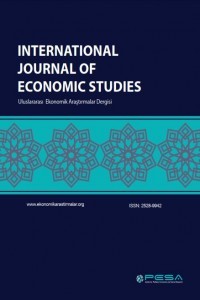THE ROLE OF MONETARY POLICY IN CONTROLLING ON INFLATION RATE IN IRAQ FOR THE PERIOD (2004 - 2020)
This paper demonstrated the role of monetary policy in controlling the inflation rate in Iraq. For this purpose, a modeling technique of the Autoregressive Distributed Lagged (ARDL) model has been used, and Monthly data has been collected for the period (31/12/2004 to 31/7/2020). Hence, the result of the unit root test for stationary implies that the inflation rate is stationary at the level, and other variables are stationary at the first difference. However, the result of the Johansen Cointegration Test reveals the relationships between inflation rate and all variables in the long run. Moreover, the Granger causality result shows two-direction causality between narrow money supply and exchange rate granger causes inflation rate. Unidirectional granger causality between inflation rate granger causes board money supply and interest rate. Finally, the outcome of the (ARDL) model reveals that the money supply and exchange rate are significant and positively related to inflation. The implication is that an increase in the money supply and exchange rate leads to high inflation in Iraq. The interest rate has a significant and contradictory relationship with the interest rate and inflation rate in Iraq. It indicates that an increase in the interest rate leads to a decrease inflation rate in Iraq.
Anahtar Kelimeler:
Inflation Rate, Money Supply (MS1. MS2), Interest Rate, Exchange Rate, Financial Crisis
___
- Ahiabor, G. (2013). The Effects of Monetary Policy on Inflation in Ghana. The international Institue for Science Technology and Education, 3(12), 82-90.
- Al- Jafari, M. K., & Abdulkadhim, H. H. (2019). Determinants of Inflation Sources in Iraq: An Application of Autoregressive Distributed Lag (ARDL) Model. The Journal of Social Science Research, 5(2), 381-388.
- Bashir, F., Nawaz, S., & and authors. (2011). Determinants Of Inflation In Pakistan: An Econometric Analysis Using Johansen Co-Integration Approach. Australian Journal In Pakistan: An and Management Research, 1(5), 71-85.
- Chaudhry, I. S., Ismail, R., Farooq, F., & Murtaza, G. (2015). Monetary policy and its inflationary pressure in Pakistan. Pakistan Economic and Social Review, 53(2), 251-268.
- Elnabawy, N., & Abonazel, M. R. (2020). Using the ARDL bound testing approach to study the inflation rate in Egypt. International Economics. International Economics / JEL F15, 31(3), 25-41.
- ERGÜN, U., & GÖKSU, A. (2013). applied Econometrics with Eviews Applications. 86-162.
- Fabian, M. E., & Charles, N. E. (2014). The Impact of Monetary Policy Rate on Inflation in Nigeria. Journal of Economics and Sustainable Development, 5(28), 146-153.
- Haldun, A. (2018). User's guide to correlation coefficients. Turkish Journal of Emergency Medicine, 18(3), 91-93.
- Haq, S., & Larsson, R. (2016). The dynamics of stock market returns and macroeconomic indicators:An ARDL approach with cointegration. KTH Industrial Engineering and Management, 1-76.
- http://www.eviews.com. (n.d.). Retrieved 12 19, 2020, from http://www.eviews.com.
- https://cbiraq.org/. (n.d.). Retrieved 12 1, 2020, from https://cbiraq.org/
- https://data.worldbank.org/. (n.d.). Retrieved 2 16, 2021, from https://data.worldbank.org/
- https://www.statisticshowto.com. (n.d.). Retrieved 12 9, 2020, fromhttps://www.statisticshowto.com.
- Hysaj, A. (2019). The relationship between monetary policy and stock prices under inflation targeting regime. Anadol University, 21-27.
- Lya, I. B., & Aminu, U. (2014). An Empirical Analysis if Determinants of Inflation in Nigeria. Journal Economics and Sustainable Development, 5(1), 140-150.
- Mankie, N. G. (2010). Macroeconomics. New York: Harvard University.
- Mishra, P. K. (2009). The Dynamics of Relationship between exports and economics groth in India. International journal of Economics Sciences and Applied Research, 4(2), 59-62.
- Nkoro, E., & Uko, A. K. (2016). Autoregressive Distributed Lag (ARDL) cointegration technique: application and interpretation. Journal od Statistical and Econometric Method, 5(4), 65-80.
- Olushina, O. A. (n.d.). On Pairwise Granger causality Modelling and Econometric Analysis of Selected Economic Indicators. 1-8.
- Onodugo, V. A., Anowor, O. F., & Ofoegbu, G. N. (2018). the effectiveness of monetary policy in tackling inflation in emerging economy. 13-56.
- Pesaran, M. H., & Shin, Y. (1997). An Autoregressive Distributed Lag Modelling Approach to Cointegration Analysis. 1-24.
- Pesaran, M. H., Shin, Y., & Smith, R. J. (2001). Bounds Testing Approaches to the Analysis of Level Relationships. Journal of Applied Econometrics, 16(3), 289-326.
- Philip, O. N., Christopher, D. A., & Pius, O. A. (2014). Effectiveness of Monetary Policy in Reducing Inflation in Nigeria. Journal of Economics and Sustainable Development, 5(13), 73-82.
- Priscilla, C. (2016). an Empirical Investigation into the Effect of Monetray policy on Inflation in Ghana. 1-60.
- ISSN: 2528-9942
- Başlangıç: 2015
- Yayıncı: Politik Ekonomik ve Sosyal Araştırmalar Merkezi
Sayıdaki Diğer Makaleler
DÜNYA TİCARET ÖRGÜTÜ UYUŞMAZLIK ÇÖZÜMÜ: TÜRK İLAÇ SEKTÖRÜ
Hande EMİN BENLİ, Neslihan TURGUTTOPBAŞ
Ülkelerin Finansal Kriz Sürecinden Çıkışını Etkileyen Faktörler: Geçmişten Edinilen Tecrübeler
Kadınlarda Eğitimin Küresel Cinsiyet Eşitliği Endeksi Üzerindeki Etkisi: Türkiye İçin Bir Uygulama
Yükselen Piyasa Ekonomilerinde İhracatın Ekonomik Büyümeye Etkisi: Panel Veri Analizi
Sivil Havacılık Sektöründe Devletin Düzenleyici Rolü: Türkiye Örneği
THE ROLE OF MONETARY POLICY IN CONTROLLING ON INFLATION RATE IN IRAQ FOR THE PERIOD (2004 - 2020)
